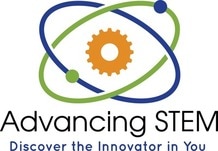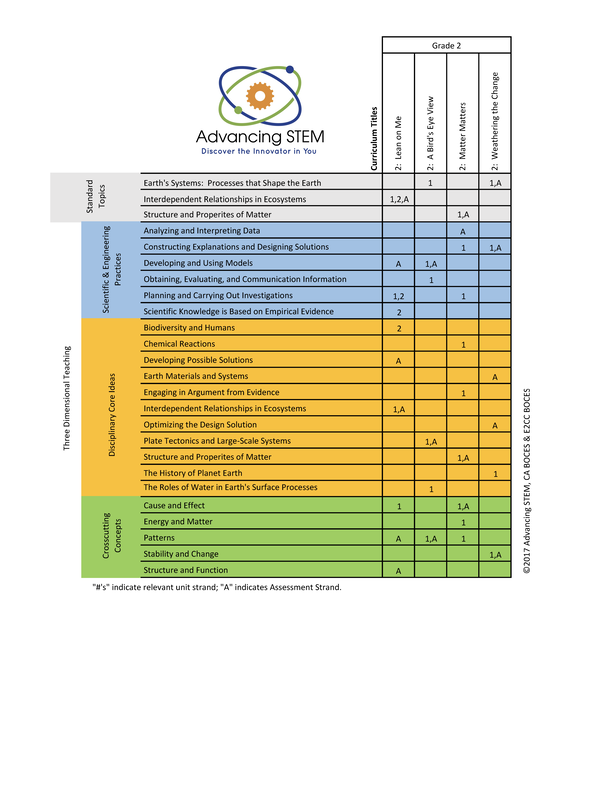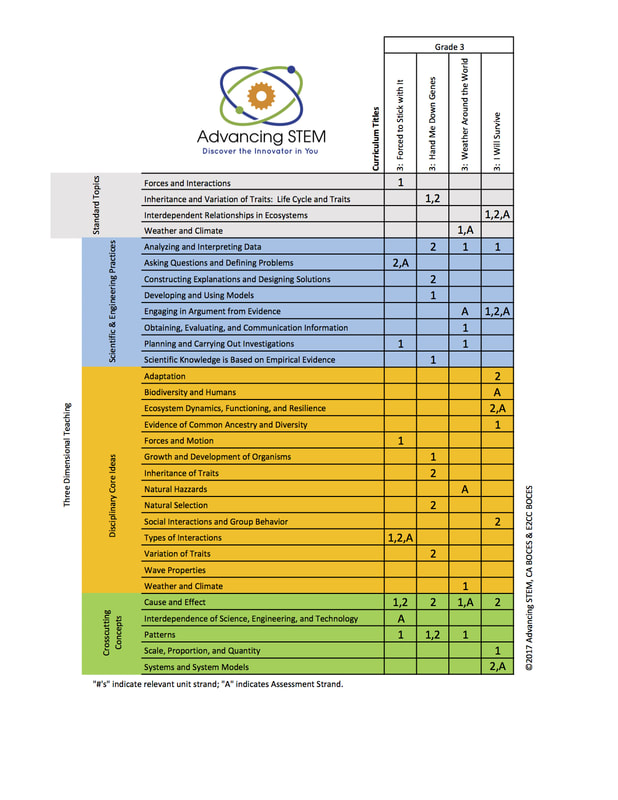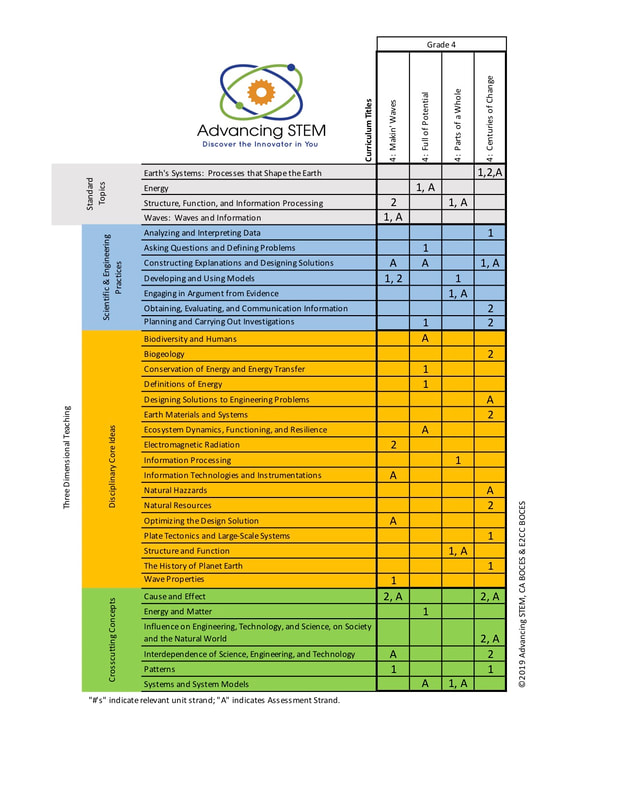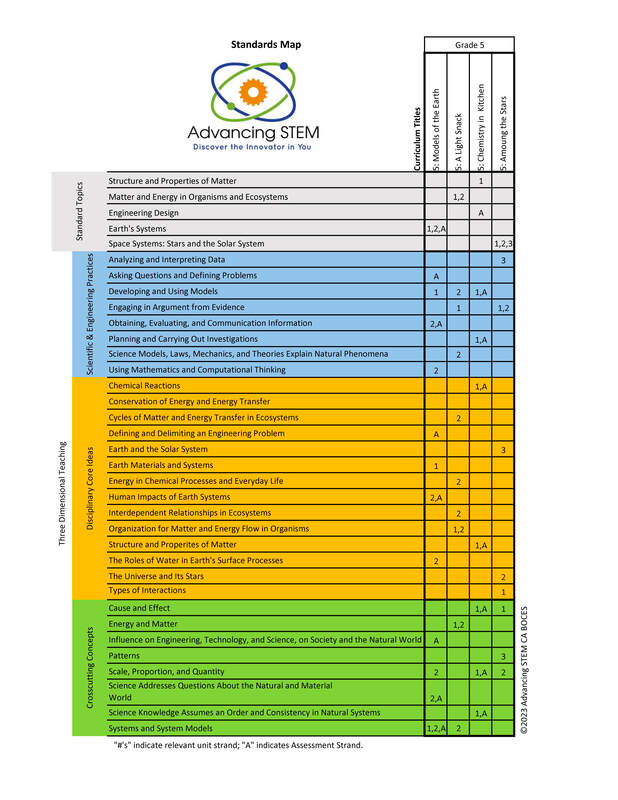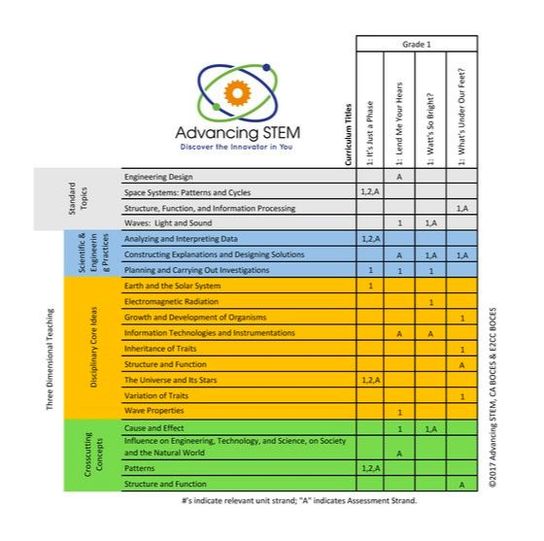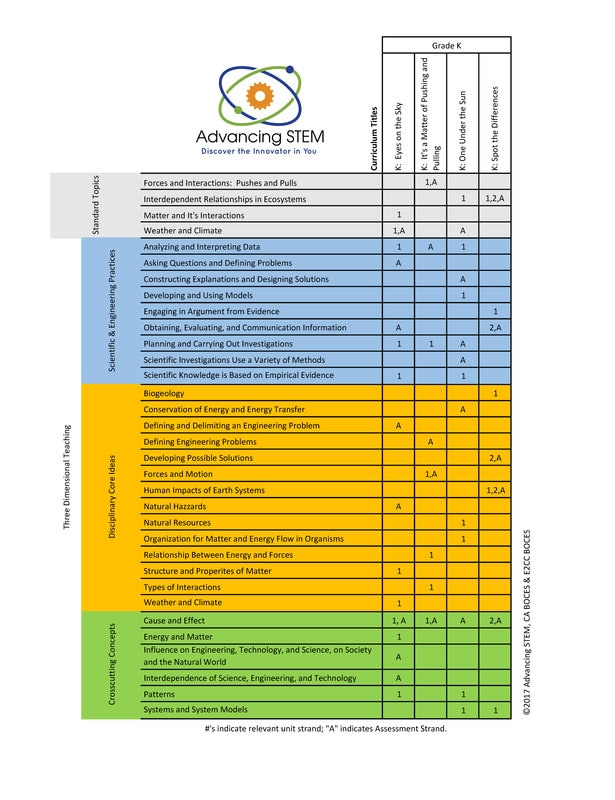AdvancingSTEM is a K-5 complete STEM curriculum for the NGSS/NYS P-12 Science Learning Standards classroom.
|
|
The Advancing STEM curriculum was written by certified New York State education specialists and reviewed by content area specialists. Our STEM Educators started with the New York State Science Standards in designing the AdvancingSTEM curriculum. Each curriculum title is build upon specific standard areas and is dedicated to delivering hands-on, constructivist experiences to your students.
The New York State Education Department has defined standards for each grade level, Kindergarten through Grade 5. Outlined below are our curriculum titles for each grade level and for each standard topic area. There are four curriculum titles for each grade level. Implementing all four titles during the school year will ensure your students are exposed to all standards, science and engineering practices, disciplinary core ideas, and crosscutting concepts. Contact us to review our curriculum manuals and student notebooks. |
The materials are highly motivating for me and my students. The student manual supports the new curriculum wonderfully. Love the monthly challenges! Everything is easy to locate. Really appreciate the extra videos provided. The curriculum and materials are highly engaging. I can't wait to use them in my classroom! I like how engaging and interesting this kit is! |
Kindergarten
<
>
Click on the curriculum titles and their connection to NYS Standards. Project members have access to all curriculum manuals, student notebooks, timelines, materials lists, and other electronic instructional materials.
Spot the Differences: Changes to the Environment
NYS Standard Topic: Matter and Its Interactions
Unit Overview Students build on their intuitive sense of patterns as they sort a variety of collections noting similarities, differences, and repeating patterns within animals’ and plants’ needs. Students explore patterns in their daily activities and in the world around them, and discuss patterns that repeat in longer cycles of time. From these patterns, students will communicate solutions and ideas of how humans can reduce the impact of their environment. Scheduling This kit contains two strands and an engineering design challenge.
It's a Matter of Pushing or Pulling: How Objects Move
NYS Standard Topic: Forces and Interactions: Pushes and Pulls
Overview Students will explore patterns in different systems that move and how they operate, as each system moves in a different but predictable pattern. Students will then design and build a contraption to change the speed or direction of an object with a push or a pull. As a result, students build a grade-level-appropriate concept of systems and an understanding of moving objects. Scheduling This kit contains one strand and an engineering design challenge.
One Under the Sun: Plant and Animal Interactions with the Sun and Their Environments
NYS Standard Topic: Interdependent Relationships in Ecosystems: Animals, Plants, and Their Environment
Overview Students will make observations about plants and animals to learn that they need food, light, and water to live and grow. Students will also learn that these essential needs are provided by the environment where they live. Using knowledge learned, students will design a structure that helps protect plants, animals, or humans from the heat of the sun. Scheduling This kit contains one strand and an Engineering Design Challenge.
Eyes to the Sky: Investigating Weather Patterns
NYS Standard Topic: Weather and Climate
Overview What is the weather like today and how is it different than yesterday? In this unit, students will develop a solid foundation for understanding weather and its impact on their daily life. Students will observe, explore, discuss, measure and formulate definitions and explanations. Scheduling This kit contains one strand and an engineering design unit assessment.
Grade 1
<
>
Click on the curriculum titles and their connection to NYS Standards. Project members have access to all curriculum manuals, student notebooks, timelines, materials lists, and other electronic instructional materials.
What's under our feet?: ANTS and PLants
NYS Standard Topic: Matter and Its Interactions
It's just a phase: patterns in the sky
NYS Standard Topic: Forces and Interactions: Pushes and Pulls
Lend me your hears: discovering sound properties
NYS Standard Topic: Interdependent Relationships in Ecosystems: Animals, Plants, and Their Environment
Watt's so bright?: discovering light properties
NYS Standard Topic: Weather and Climate
Grade 2
<
>
Click on the curriculum titles and their connection to NYS Standards. Project members have access to all curriculum manuals, student notebooks, timelines, materials lists, and other electronic instructional materials.
Matter matters: Properties of matter
Science Standards
A bird's eye view over land and Water: Models, Maps, and Patterns
NYS Standard Topic: Forces and Interactions:
lean on me: plant and animal dependency
NYS Standard Topic: Matter and Its Interactions
Weathering the change: Erosion Processes
NYS Standard Topic: Weather and Climate
The table below shows how standard topics, science and engineering practices, disciplinary core ideas, and crosscutting concepts are distributed across curriculum titles.
1 - Strand One, 2 - Strand Two, A - Assessment Strand
Note - number of strands vary from title to title. The four Grade 2 curriculum units cover the breadth and depth of every Grade 2 level New York State Standard. All four standard topics are explored in the depth appropriate for the Grade 2 student. The performance expectations in second grade help students formulate answers to questions such as: “How does land change and what are some things that cause it to change? What are the different kinds of land and bodies of water? How are materials similar and different from one another, and how do the properties of the materials relate to their use? What do plants need to grow? How many types of living things live in a place?” Students are expected to develop an understanding of what plants need to grow and how plants depend on animals for seed dispersal and pollination. Students are also expected to compare the diversity of life in different habitats. An understanding of observable properties of materials is developed by students at this level through analysis and classification of different materials. Students are able to apply their understanding of the idea that wind and water can change the shape of the land to compare design solutions to slow or prevent such change. Students are able to use information and models to identify and represent the shapes and kinds of land and bodies of water in an area and where water is found on Earth. The crosscutting concepts of patterns; cause and effect; energy and matter; structure and function; stability and change; and influence of engineering, technology, and science on society and the natural world are called out as organizing concepts for these disciplinary core ideas. In the second grade performance expectations, students are expected to demonstrate grade appropriate proficiency in developing and using models, planning and carrying out investigations, analyzing and interpreting data, constructing explanations and designing solutions, engaging in argument from evidence, and obtaining, evaluating, and communicating information. Students are expected to use these practices to demonstrate understanding of the core ideas. Grade 3
<
>
Click on the curriculum titles and their connection to NYS Standards. Project members have access to all curriculum manuals, student notebooks, timelines, materials lists, and other electronic instructional materials.
Forced to stick with it: motion and magnetism
NYS Standard Topic: Forces and Interactions
Unit Overview In this unit, students will explore the role of forces. They will discover the impact gravity, electric, and magnetic forces have on objects in the world. Using this knowledge, students will apply ideas to solve a real-world problem. This is part of the Engineering Design Challenge and will task students with creating a system to propel and stop a train at specific locations using magnets. Hand-me-down genes: life cycles and traits of butterflies
NYS Standards Topic: Earth's Systems: Processes that Shape the Earth
Unit Overview This unit covers the life cycle of a butterfly and then expands upon that concept. The students will journal the development of the Painted Lady from egg until butterfly. The kit also covers inherited vs. acquired traits and how the traits are exhibited in an organism. Students will explore how traits can cause or lead to natural selection within a species. Weather around the world: Data trends, Climate, water cycle, and hazards
NYS Standard Topic: Weather and Climate
Unit Overview Students are introduced to the causes of weather and climate, and also study how the water cycle plays an important role in a region’s climate. They begin the unit by building mystery weather tools (thermometer, anemometer, psychrometer, and barometer) and examine the tools as they learn to collect weather data. Students will deduce, by comparing their collected weather data using scientific instruments, which mystery tool their group has created. Throughout the unit, students collect weather data and graph their data on charts. Students also build a water cycle model and relate their new learning of the water cycle to weather conditions. They explore how different regions of Earth can be heated unevenly, causing specific weather patterns in different climates. By the end of the unit, students make the connection between the effects of weather on humans and how we can predict and prepare for hazardous weather. I will survive: Organisms surviving in different environments
NYS Standard Topic: Interdependent Relationships in Ecosystems
Unit Overview Students explore the diversity of living organisms, a significant element of a healthy environment. Students explore changes among living things on Earth when the environment changes by exploring different fossils. Throughout the unit, they observe and investigate how characteristics, such as living in groups, can help animals/plants around the world survive in different environments. The table below shows how standard topics, science and engineering practices, disciplinary core ideas, and crosscutting concepts are distributed across curriculum titles.
1 - Strand One, 2 - Strand Two, A - Assessment Strand Note - number of strands vary from title to title. The four Grade 3 curriculum units cover the breadth and depth of every Grade 3 level New York State Standard. All four standard topics are explored in the depth appropriate for the Grade 3 student. The performance expectations in third grade help students formulate answers to questions such as: “What is typical weather in different parts of the world and during different times of the year? How can the impact of weather-related hazards be reduced? How do organisms vary in their traits? How are plants, animals, and environments of the past similar or different from current plants, animals, and environments? What happens to organisms when their environment changes? How do equal and unequal forces on an object affect the object? How can magnets be used?” Students are able to organize and use data to describe typical weather conditions expected during a particular season. By applying their understanding of weather-related hazards, students are able to make a claim about the merit of a design solution that reduces the impacts of such hazards. Students are expected to develop an understanding of the similarities and differences of organisms’ life cycles. An understanding that organisms have different inherited traits, and that the environment can also affect the traits that an organism develops, is acquired by students at this level. In addition, students are able to construct an explanation using evidence for how the variations in characteristics among individuals of the same species may provide advantages in surviving, finding mates, and reproducing. Students are expected to develop an understanding of types of organisms that lived long ago and also about the nature of their environments. Third graders are expected to develop an understanding of the idea that when the environment changes some organisms survive and reproduce, some move to new locations, some move into the transformed environment, and some die. Students are able to determine the effects of balanced and unbalanced forces on the motion of an object and the cause and effect relationships of electric or magnetic interactions between two objects not in contact with each other. They are then able to apply their understanding of magnetic interactions to define a simple design problem that can be solved with magnets. The crosscutting concepts of patterns; cause and effect; scale, proportion, and quantity; systems and system models; interdependence of science, engineering, and technology; and influence of engineering, technology, and science on society and the natural world are called out as organizing concepts for these disciplinary core ideas. In the third grade performance expectations, students are expected to demonstrate grade-appropriate proficiency in asking questions and defining problems; developing and using models, planning and carrying out investigations, analyzing and interpreting data, constructing explanations and designing solutions, engaging in argument from evidence, and obtaining, evaluating, and communicating information. Students are expected to use these practices to demonstrate understanding of the core ideas. Grade 4
<
>
Click on the curriculum titles and their connection to NYS Standards. Project members have access to all curriculum manuals, student notebooks, timelines, materials lists, and other electronic instructional materials.
Makin' Waves: Patterns of waves and information Transfer
NYS Standard Topic: Waves and Information Processing
Unit Overview Students explore wave properties and their regular patterns of motion. Students will make a model of waves of the same type to show differences in amplitude and wavelength. They will explore the idea of how an object can be seen when light reflected from its surface enters the eyes through different mediums. As a culmination, students will generate and compare how digitized information can be transmitted over long distances using patterns of waves. Scheduling This kit contains two strands.
full of potential: The effects of Energy
NYS Standard Topic: Energy
Unit Overview Students explore the effects of energy on their lives. Throughout the unit students will be asked to explore some of the basic elements of energy like conservation and transfer of energy. Students will explore these ideas through a series of four experiments and application to their lives. Students will collect evidence from these experiments to build on their overall concepts of energy and how it can be used. Finally, students will explore multiple types of energy by building a working solar updraft tower. Scheduling This kit contains one strand and an Engineering Design Challenge.
Parts of a Whole: Internal and External Plant and Animal Structures
NYS Standard Topic: Structure, Function, and Information Processing
Unit Overview The unit is designed to enhance students’ knowledge of how plants’ and animals’ internal and external structures support their survival, growth, behavior, and reproduction. Students must learn to construct an argument that explains how these internal and external structures support survival, growth, behavior, and reproduction. The kit will require students to engage in argument from evidence as they state their claims, provide evidence, and justify their claims with scientific reasoning. The kit culminates with a project-based assessment activity in which the students must present their choice of plant or animal to their classmates and answer the driving question, what internal and external structures do plants and animals have that function to support survival, growth, behavior, and reproduction? Scheduling This kit contains one strand.
Centuries of change: processes that shape the earth
NYS Standard Topic: Earth's Systems: Processes that Shape the Earth
Unit Overview Students explore processes that shape the earth as we know it today by exploring how a variety of environmental factors. Students will look at how evidence from patterns in rock formations and fossils found in those layers help us explain changes to landscapes over a long period of time. Students will also look at how analyzing patterns in maps of Earth’s features help us to determine and predict features of plate tectonics, including continental boundaries, mountains, volcanoes, and earthquakes. Students will also explore how elements such as weathering, erosion, and the use of fossil fuels will transform the landscape for future generations. Scheduling This kit contains two strands and an Engineering Design Challenge.
The table below shows how standard topics, science and engineering practices, disciplinary core ideas, and crosscutting concepts are distributed across curriculum titles.
1 - Strand One, 2 - Strand Two, A - Assessment Strand Note - number of strands vary from title to title. The four Grade 4 curriculum units cover the breadth and depth of every Grade 4 level New York State Standard. All four standard topics are explored in the depth appropriate for the Grade 4 student. The performance expectations in fourth grade help students formulate answers to questions such as: “What are waves and what are some things they can do? How can water, ice, wind and vegetation change the land? What patterns of Earth’s features can be determined with the use of maps? How do internal and external structures support the survival, growth, behavior, and reproduction of plants and animals? What is energy and how is it related to motion? How is energy transferred? How can energy be used to solve a problem?” Students are able to use a model of waves to describe patterns of waves in terms of amplitude and wavelength, and that waves can cause objects to move. Students are expected to develop understanding of the effects of weathering or the rate of erosion by water, ice, wind, or vegetation. They apply their knowledge of natural Earth processes to generate and compare multiple solutions to reduce the impacts of such processes on humans. In order to describe patterns of Earth’s features, students analyze and interpret data from maps. Fourth graders are expected to develop an understanding that plants and animals have internal and external structures that function to support survival, growth, behavior, and reproduction. By developing a model, they describe that an object can be seen when light reflected from its surface enters the eye. Students are able to use evidence to construct an explanation of the relationship between the speed of an object and the energy of that object. Students are expected to develop an understanding that energy can be transferred from place to place by sound, light, heat, and electric currents or from object to object through collisions. They apply their understanding of energy to design, test, and refine a device that converts energy from one form to another. The crosscutting concepts of patterns; cause and effect; energy and matter; systems and system models; interdependence of science, engineering, and technology; and influence of engineering, technology, and science on society and the natural world are called out as organizing concepts for these disciplinary core ideas. In the fourth grade performance expectations, students are expected to demonstrate grade-appropriate proficiency in asking questions, developing and using models, planning and carrying out investigations, analyzing and interpreting data, constructing explanations and designing solutions, engaging in argument from evidence, and obtaining, evaluating, and communicating information. Students are expected to use these practices to demonstrate understanding of the core ideas. Grade 5
<
>
Click on the curriculum titles and their connection to NYS Standards. Project members have access to all curriculum manuals, student notebooks, timelines, materials lists, and other electronic instructional materials.
Chemistry in the Kitchen: Structure and properties of Matter
NYS Standard Topic: Structure and Properties of Matter
Unit Overview In this unit, students explore concepts related to the structure and properties of matter. This will include developing models to show that matter is made up of particles too small to be seen and making observations and measurements to identify materials based on their properties. Students will also measure and graph quantities to provide evidence that matter is neither created nor destroyed when changing it in any way including heating, cooling, and mixing. Finally, students will conduct investigations to determine wheter mixing two or more substances results in new substances. Scheduling This kit contains one strand and an Engineering Design Challenge.
A Light Snack: Energy and Matter in Ecosystems
NYS Standard Topic: Matter and Energy in Organisms and Ecosystems
Unit Overview Students explore the relationships between the flow of energy and cycling of matter in an ecosystem. Students will make models of energy flows and matter within ecosystems showing how organisms rely on the sun for repair, growth, motion, and warmth. They will explore the importance of plants in an ecosystem and support an argument of where plants get their materials for growth. Concurrently, students will set up and observe ecosystem models and how the individual components benefit the entire system. Scheduling This kit contains two strands.
Models of the Earth: Earth's Systems and Water Resources
NYS Standard Topic: Earth's Systems
Unit Overview The lessons are designed to enhance students’ knowledge of the four major spheres of the Earth and how water is distributed in the hydrosphere. Students must learn to construct an argument that explains how the four spheres interact with each other. The kit will require students to engage in argument from evidence as they state their claims, provide evidence, and justify their claims with scientific reasoning. The kit culminates with an engineering design assessment activity in which the students must research and create a simple water filter. Scheduling This kit contains two strands and an engineering design challenge.
Among the Stars: Earth and Space Systems
NYS Standard Topic: Earth and Space Systems
Unit Overview In this unit, students explore gravity, stars, and patterns in our sky. Throughout the unit students will be asked to explore how gravity works on a spherical object like our planet, how our Sun compares to other stars, and how we use celestial objects to understand the passage of time. Students will explore these ideas through a series of investigations and application to their lives. Students will collect evidence from these investigations to build on their overall concepts of space. Finally, students will explore the Sun’s motions related to time by building a sundial. Scheduling This kit contains three strands and an Engineering Design Challenge.
The table below shows how standard topics, science and engineering practices, disciplinary core ideas, and crosscutting concepts are distributed across curriculum titles.
1 - Strand One, 2 - Strand Two, A - Assessment Strand Note - number of strands vary from title to title. The four Grade 5 curriculum units cover the breadth and depth of every Grade 5 level New York State Standard. All four standard topics are explored in the depth appropriate for the Grade 5 student. The performance expectations in fifth grade help students formulate answers to questions such as: “When matter changes, does its weight change? How much water can be found in different places on Earth? Can new substances be created by combining other substances? How does matter cycle through ecosystems? Where does the energy in food come from and what is it used for? How do lengths and directions of shadows or relative lengths of day and night change from day to day, and how does the appearance of some stars change in different seasons?” Students are able to describe that matter is made of particles too small to be seen through the development of a model. Students develop an understanding of the idea that regardless of the type of change that matter undergoes, the total weight of matter is conserved. Students determine whether the mixing of two or more substances results in new substances. Through the development of a model using an example, students are able to describe ways the geosphere, biosphere, hydrosphere, and/or atmosphere interact. They describe and graph data to provide evidence about the distribution of water on Earth. Students develop an understanding of the idea that plants get the materials they need for growth chiefly from air and water. Using models, students can describe the movement of matter among plants, animals, decomposers, and the environment and that energy in animals’ food was once energy from the sun. Students are expected to develop an understanding of patterns of daily changes in length and direction of shadows, day and night, and the seasonal appearance of some stars in the night sky. The crosscutting concepts of patterns; cause and effect; scale, proportion, and quantity; energy and matter; and systems and systems models are called out as organizing concepts for these disciplinary core ideas. In the fifth grade performance expectations, students are expected to demonstrate grade-appropriate proficiency in developing and using models, planning and carrying out investigations, analyzing and interpreting data, using mathematics and computational thinking, engaging in argument from evidence, and obtaining, evaluating, and communicating information; and to use these practices to demonstrate understanding of the core ideas. The table below shows how standard topics, science and engineering practices, disciplinary core ideas, and crosscutting concepts are distributed across curriculum titles.
1 - Strand One, 2 - Strand Two, A - Assessment Strand
Note - number of strands vary from title to title. The four Grade 1 curriculum units cover the breadth and depth of every Grade 1 level New York State Standard. All four standard topics are explored in the depth appropriate for the Grade 1 student. The performance expectations in first grade help students formulate answers to questions such as: “What happens when materials vibrate? What happens when there is no light? What are some ways plants and animals meet their needs so that they can survive and grow? How are parents and their children similar and different? What objects are in the sky and how do they seem to move?” Students are expected to develop understanding of the relationship between sound and vibrating materials as well as between the availability of light and ability to see objects. The idea that light travels from place to place can be understood by students at this level through determining the effect of placing objects made with different materials in the path of a beam of light. Students are also expected to develop understanding of how plants and animals use their external parts to help them survive, grow, and meet their needs as well as how behaviors of parents and offspring help the offspring survive. The understanding is developed that young plants and animals are like, but not exactly the same as, their parents. Students are able to observe, describe, and predict some patterns of the movement of objects in the sky. The crosscutting concepts of patterns; cause and effect; structure and function; and influence of engineering, technology, and science on society and the natural world are called out as organizing concepts for these disciplinary core ideas. In the first grade performance expectations, students are expected to demonstrate grade-appropriate proficiency in planning and carrying out investigations, analyzing and interpreting data, constructing explanations and designing solutions, and obtaining, evaluating, and communicating information. Students are expected to use these practices to demonstrate understanding of the core ideas. The table below shows how standard topics, science and engineering practices, disciplinary core ideas, and crosscutting concepts are distributed across curriculum titles.
1 - Strand One, 2 - Strand Two, A - Assessment Strand Note - number of strands vary from title to title. The four Kindergarten curriculum units cover the breadth and depth of every Kindergarten grade level New York State Standard. All four standard topics are explored in the depth appropriate for the Kindergarten student. The performance expectations in kindergarten help students formulate answers to questions such as: “What happens if you push or pull an object harder? Where do animals live and why do they live there? What is the weather like today and how is it different from yesterday?” Students are expected to develop understanding of patterns and variations in local weather and the purpose of weather forecasting to prepare for, and respond to, severe weather. Students are able to apply an understanding of the effects of different strengths or different directions of pushes and pulls on the motion of an object to analyze a design solution. Students are also expected to develop understanding of what plants and animals (including humans) need to survive and the relationship between their needs and where they live. The crosscutting concepts of patterns; cause and effect; systems and system models; interdependence of science, engineering, and technology; and influence of engineering, technology, and science on society and the natural world are called out as organizing concepts for these disciplinary core ideas. In the kindergarten performance expectations, students are expected to demonstrate grade-appropriate proficiency in asking questions, developing and using models, planning and carrying out investigations, analyzing and interpreting data, designing solutions, engaging in argument from evidence, and obtaining, evaluating, and communicating information. Students are expected to use these practices to demonstrate understanding of the core ideas. |
